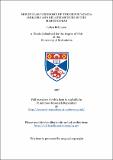Files in this item
Molecular taxonomy of the genus 'Acacia (Miller)' and related species in the mimosoideae
Item metadata
| dc.contributor.advisor | Ingram, Ruth | |
| dc.contributor.author | Robinson, Julian | |
| dc.coverage.spatial | 235 p. | en_US |
| dc.date.accessioned | 2018-06-18T12:41:49Z | |
| dc.date.available | 2018-06-18T12:41:49Z | |
| dc.date.issued | 1997 | |
| dc.identifier.uri | https://hdl.handle.net/10023/14197 | |
| dc.description.abstract | The construction of a chloropast DNA restriction enzyme site based phylogeny for the genus Acacia and several related genera was completed. This investigation was initiated due to a perceived need for an independent viewpoint on the phylogeny of the genus. The results of this analysis challenge several previous attempts at classification of the genus using morphological characters. The cpDNA data suggest that subgenus Acacia and subgenus Aculeiferum are closely related. The third subgenus of Acacia, subgenus Phyilodineae, is probably unrelated to either of the other two subgenera. Instead it appears to be closely related to taxa in the Ingeae, a sister tribe to the Acacieae. This analysis also suggests that Faidherbia albida is basal to the Ingeae. The interspecific relationships of taxa within each of the subgenera of Acacia were also partly resolved. Within subgenus Acacia the African accessions studied could not be resolved due to a lack of variation. The American accessions of subgenus Acacia were resolved, and appear to confirm groupings within these taxa suggested by morphological analyses. Within subgenus Aculeiferum the interspecific relationships were less clear, and little support was given to the sections proposed by Vassal (1972), with the exception of section Filicinae, which appears to be monophyletic, the relationships of taxa within subgenus Aculeiferum in regard to their geographical origin suggest that subgenus Aculeiferum was quite well differentiated when Gondwanaland fragmented. The results of an investigation into the putative hybrid A.laeta appear to confirm earlier suggestions that it is a hybrid between A.Senegal and A.mellifera. The appearance of non-additive hybrid phenotypes in the ribosomal nuclear DNA studied prevented an unequivocal determination of the parents of A.laeta. On the basis of the cpDNA characters it appears that A.mellifera is always the maternal parent. The relationships of the subspecies of A.tortilis using RAPD techniques, revealed an interesting divide between North African and South African accessions. The taxa studied appeared to be grouped primarily according to their geographical location, the subspecific designation appearing to be of secondary importance. The divide between the accessions appears to be the boundary of one of the phytogeographical regions of Wickens (1976), corresponding approximately to the Kenyan-Tanzanian border. The physical or biological basis for this boundary is unknown. The investigation also proved the utility of the RAPD technique for investigations of this nature. | en_US |
| dc.language.iso | en | en_US |
| dc.publisher | University of St Andrews | |
| dc.subject.lcc | QK495.L52R7 | en |
| dc.subject.lcsh | Legumes | en |
| dc.title | Molecular taxonomy of the genus 'Acacia (Miller)' and related species in the mimosoideae | en_US |
| dc.type | Thesis | en_US |
| dc.contributor.sponsor | University of St Andrews | en_US |
| dc.type.qualificationlevel | Doctoral | en_US |
| dc.type.qualificationname | PhD Doctor of Philosophy | en_US |
| dc.publisher.institution | The University of St Andrews | en_US |
This item appears in the following Collection(s)
Items in the St Andrews Research Repository are protected by copyright, with all rights reserved, unless otherwise indicated.

